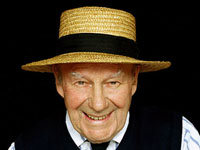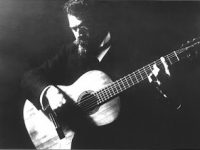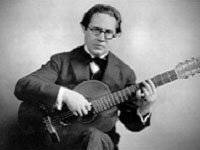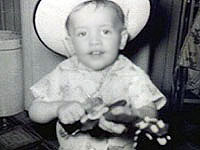Delpriora: Variations on a Theme by Sor – Nathan Cornelius
Remarks from Mr. Cornelius:
American guitarist and composer Mark Delpriora teaches at the Manhattan School of Music in New York. He describes the imaginary program behind this set of variations on a brief Menuet in C minor by Fernando Sor as “an epic journey: a sheet of manuscript paper on which Sor’s Menuet is written is taken by a gust of wind through time and space and onto the desk of my favorite composers.” Each composer transforms the theme into his distinctive style, setting the stage for subtle musical jokes and allusions along the way.
The variations begin with Sor’s contemporary and acquaintance, Beethoven, who draws on the famous C-minor march from his “Eroica” Symphony. A miniature sonata-allegro movement in A major, inspired by Clementi, provides strong tonal contrast, and a cheery ländler or German dance is full of the bold modulations for which Schubert is well-known. Robert Schumann, who created the musical alter-egos Florestan and Eusebius for the two sides of his personality, appropriately bifurcates into two movements, inspired by two of his Symphonic Etudes, surrounding a dark and Chopinesque nocturne.
Moving into the middle of the 19th century, we hear a ballade in the style of Brahms’ famous “Edward” Ballade, followed by a mercurial scherzo inspired by the scene “Queen Mab, the Dream Fairy” from Berlioz’s ballet Romeo and Juliet. A weighty funeral march, easily the longest variation of the set, quotes not only from the famous funeral of Siegfried near the end of Wagner’s Ring cycle but also from Sor’s Fantaisie Elegiaque sur la mort de Mme. Beslay, in which the grief-stricken composer wrote “Charlotte! Adieu!” above the closing strains (hence the subtitle).
The tragic atmosphere is soothed by a tender berceuse or lullaby in the style of Fauré’s Berceuse for violin, followed by a harmonically audacious prelude à la Scriabin, who wrote dozens of such works. The ensuing intermezzo is a textbook example of the twelve-tone style invented by Schönberg, with the row clearly presented at the beginning and then transformed through retrograde and inversion. A dense and heroic fugue closes out the work, much as in Busoni’s Variations and Fugue on a Prelude by Chopin, another piece based on transformations of earlier music. Delpriora particularly admires Busoni for his “affectionate, playful view of history,” in which he finds “a way forward towards which I am sympathetic.”
0:01 Theme Menuet (Op. 24, No. 1, [Fernando Sor])
2:38 Var. 1. Marcia (Pensando di Ludwig van Beethoven…)
4:24 Var. 2. Sonatinetta (Pensando di Muzio Clementi…)
7:14 Var. 3. Ländler (Pensando di Franz Schubert…)
9:47 Var. 4. Etude I (Pensando di Robert Schumann…)
11:12 Var. 5. Nocturne (Pensando di Fryderyk Chopin…)
14:18 Var. 7. Etude II (Pensando di Robert Schumann…)
16:00 Var. 8. Ballade (Pensando di Johannes Brahms…)
18:51 Var. 9. Scherzo (Pensando di Hector Berlioz…)
23:14 Var. 10. March Fùnebre – Liebestraum, reminiscences of Charlotte (Pensando di Richard Wagner…)
31:35 Var. 11. Berceuse (Pensando di Gabriel Fauré…)
34:28 Var. 12. Prelude (Pensando di Alexander Scribain…)
36:27 Var. 13. Intermezzo (Pensando di Arnold Schönberg…)
39:30 Var. 14. Fugue (Pensando di Ferruccio Busoni…)
Jangle Bells
Ok, Jingle Bells, arranged for ukuleles and guitar orchestra by the always adventurous composer Nikita Koshkin. The player is Marina Krupkina.
Pepe Romero Plays Aranjuez
Pepe and the conductor were old friends. Watch closely at the final note.














